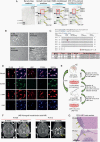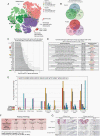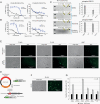A preclinical model of patient-derived cerebrospinal fluid circulating tumor cells for experimental therapeutics in leptomeningeal disease from melanoma
- PMID: 35213727
- PMCID: PMC9527526
- DOI: 10.1093/neuonc/noac054
A preclinical model of patient-derived cerebrospinal fluid circulating tumor cells for experimental therapeutics in leptomeningeal disease from melanoma
Erratum in
-
Corrigendum to: A preclinical model of patient-derived cerebrospinal fluid circulating tumor cells for experimental therapeutics in leptomeningeal disease from melanoma.Neuro Oncol. 2022 Nov 2;24(11):2009. doi: 10.1093/neuonc/noac181. Neuro Oncol. 2022. PMID: 35904120 Free PMC article. No abstract available.
Abstract
Background: Leptomeningeal disease (LMD) occurs as a late complication of several human cancers and has no rationally designed treatment options. A major barrier to developing effective therapies for LMD is the lack of cell-based or preclinical models that recapitulate human disease. Here, we describe the development of in vitro and in vivo cultures of patient-derived cerebrospinal fluid circulating tumor cells (PD-CSF-CTCs) from patients with melanoma as a preclinical model to identify exploitable vulnerabilities in melanoma LMD.
Methods: CSF-CTCs were collected from melanoma patients with melanoma-derived LMD and cultured ex vivo using human meningeal cell-conditioned media. Using immunoassays and RNA-sequencing analyses of PD-CSF-CTCs, molecular signaling pathways were examined and new therapeutic targets were tested for efficacy in PD-CSF-CTCs preclinical models.
Results: PD-CSF-CTCs were successfully established both in vitro and in vivo. Global RNA analyses of PD-CSF-CTCs revealed several therapeutically tractable targets. These studies complimented our prior proteomic studies highlighting IGF1 signaling as a potential target in LMD. As a proof of concept, combining treatment of ceritinib and trametinib in vitro and in vivo demonstrated synergistic antitumor activity in PD-CSF-CTCs and BRAF inhibitor-resistant melanoma cells.
Conclusions: This study demonstrates that CSF-CTCs can be grown in vitro and in vivo from some melanoma patients with LMD and used as preclinical models. These models retained melanoma expression patterns and had signaling pathways that are therapeutically targetable. These novel models/reagents may be useful in developing rationally designed treatments for LMD.
Keywords: ceritinib; leptomeningeal disease (LMD); melanoma; patient-derived CSF-CTCs (PD-CSF-CTCs); single-cell RNA sequencing.
© The Author(s) 2022. Published by Oxford University Press on behalf of the Society for Neuro-Oncology.
Figures




Comment in
-
Preclinical modeling in leptomeningeal disease: Starting at the foundation to tackle a difficult disease.Neuro Oncol. 2022 Oct 3;24(10):1687-1688. doi: 10.1093/neuonc/noac142. Neuro Oncol. 2022. PMID: 35751573 Free PMC article. No abstract available.
Similar articles
-
Leptomeningeal Disease (LMD) in Patients with Melanoma Metastases.Cancers (Basel). 2023 Mar 21;15(6):1884. doi: 10.3390/cancers15061884. Cancers (Basel). 2023. PMID: 36980770 Free PMC article. Review.
-
Ex Vivo Culture of Circulating Tumor Cells in the Cerebral Spinal Fluid from Melanoma Patients to Study Melanoma-Associated Leptomeningeal Disease.J Vis Exp. 2024 Mar 29;(205). doi: 10.3791/66071. J Vis Exp. 2024. PMID: 38619274
-
Clinical Utility of a Circulating Tumor Cell-Based Cerebrospinal Fluid Assay in the Diagnosis and Molecular Analysis of Leptomeningeal Disease in Patients With Advanced Non-Small Cell Lung Cancer.JCO Precis Oncol. 2024 Dec;8:e2400373. doi: 10.1200/PO-24-00373. Epub 2024 Dec 12. JCO Precis Oncol. 2024. PMID: 39666928
-
Tumor DNA in cerebral spinal fluid reflects clinical course in a patient with melanoma leptomeningeal brain metastases.J Neurooncol. 2016 May;128(1):93-100. doi: 10.1007/s11060-016-2081-5. Epub 2016 Mar 9. J Neurooncol. 2016. PMID: 26961773 Free PMC article.
-
Cerebral spinal fluid analyses and therapeutic implications for leptomeningeal metastatic disease.J Neurooncol. 2025 Mar;172(1):31-40. doi: 10.1007/s11060-024-04902-0. Epub 2024 Dec 20. J Neurooncol. 2025. PMID: 39704899 Review.
Cited by
-
Leptomeningeal Disease (LMD) in Patients with Melanoma Metastases.Cancers (Basel). 2023 Mar 21;15(6):1884. doi: 10.3390/cancers15061884. Cancers (Basel). 2023. PMID: 36980770 Free PMC article. Review.
-
The anatomic basis of leptomeningeal metastasis.J Exp Med. 2024 Apr 1;221(4):e20212121. doi: 10.1084/jem.20212121. Epub 2024 Mar 7. J Exp Med. 2024. PMID: 38451255 Free PMC article. Review.
-
The path to leptomeningeal metastasis.Nat Rev Cancer. 2024 Jul;24(7):448-460. doi: 10.1038/s41568-024-00700-y. Epub 2024 Jun 13. Nat Rev Cancer. 2024. PMID: 38871881 Free PMC article. Review.
-
Preclinical modeling in leptomeningeal disease: Starting at the foundation to tackle a difficult disease.Neuro Oncol. 2022 Oct 3;24(10):1687-1688. doi: 10.1093/neuonc/noac142. Neuro Oncol. 2022. PMID: 35751573 Free PMC article. No abstract available.
-
Leptomeningeal metastatic disease: new frontiers and future directions.Nat Rev Clin Oncol. 2025 Feb;22(2):134-154. doi: 10.1038/s41571-024-00970-3. Epub 2024 Dec 9. Nat Rev Clin Oncol. 2025. PMID: 39653782 Review.
References
-
- Larkin J, Chiarion-Sileni V, Gonzalez R, et al. Five-year survival with combined nivolumab and ipilimumab in advanced melanoma. N Engl J Med. 2019;381(16):1535–1546. - PubMed
Publication types
MeSH terms
Substances
Grants and funding
LinkOut - more resources
Full Text Sources
Medical
Research Materials
Miscellaneous

